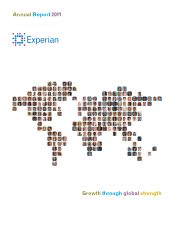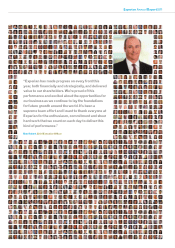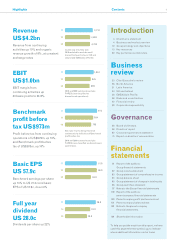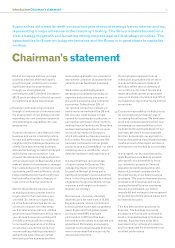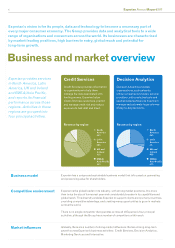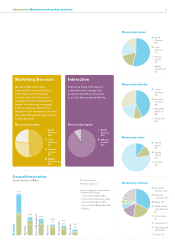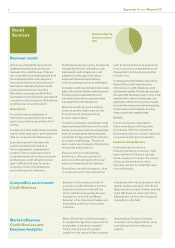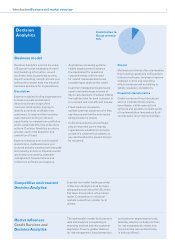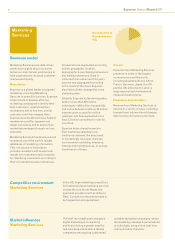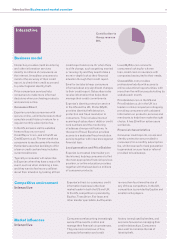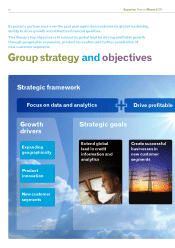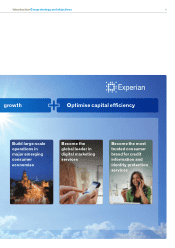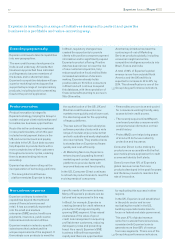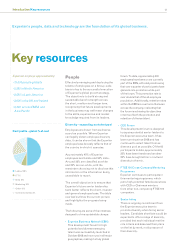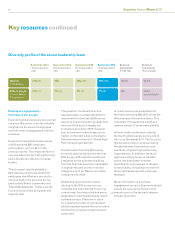Experian 2011 Annual Report Download - page 8
Download and view the complete annual report
Please find page 8 of the 2011 Experian annual report below. You can navigate through the pages in the report by either clicking on the pages listed below, or by using the keyword search tool below to find specific information within the annual report.
xx Experian Annual Report 2011
6
At the core of Credit Services are the
databases that Experian builds and
manages, the credit bureaux. They are
very comprehensive databases and hold
the credit application and repayment
histories of millions of consumers and
businesses. Globally, Experian holds
credit payment data on more than
600 million consumers and 60 million
businesses. In total, Experian operates 16
consumer credit bureaux and 12 business
credit bureaux around the world.
Description
A credit bureau is a database of
information supplied by lenders and
public record data sourced from third
parties.
Lenders and other subscribing members
submit credit application and repayment
data on consumers and businesses.
Experian augments that data with
publicly available information. It
is then aggregated, cleansed and
sorted to form a credit report which
comprehensively shows how consumer
and business credit obligations have
been fulfilled in the past, forming a
complete picture of indebtedness
and credit payment behaviour.
Credit reports vary by country, but typically
include identification information, past
and present credit obligations, court
judgments, bankruptcy information,
suspected fraudulent applications,
collections data and previous addresses.
Consumer credit reports help lenders make
better informed and faster credit decisions
through access to detailed historical
information about how consumers have
managed their credit obligations.
Business credit reports are used by
clients to set the credit terms for new
accounts and to manage existing
account relationships.
To check a consumer’s or business’ credit
history and store information with a credit
bureau, a company must have a legitimate
need for accessing the data and usually
must notify the applicant of their intention
to contact a credit bureau. The laws of
each country vary in respect of the hosting
of such data and access to it.
Experian does not make lending
decisions or offer any comment or
advice on particular applications, but
simply provides factual information.
Clients then use that information, often
in conjunction with other information
such as that included in an application
form or any previous agreements with
the applicant, to help decide whether
to lend or not.
In developed credit markets, such as the
US and UK, a credit report includes
information on credit obligations, both
positive and negative. Positive data includes
accounts that have been paid on time, while
negative information includes past-due
payments, collection accounts and public
records information such as bankruptcies.
In less mature credit markets, bureaux
often contain only negative data.
Clients
Clients include any organisation
that is extending or offering credit,
for example, financial institutions,
telecommunications, utilities, insurance
companies and automotive dealers.
Financial characteristics
Credit reports are sold on a
transactional basis, priced per credit
report delivered. Pricing is typically
tiered, varying according to the volume
of reports delivered to the client.
Typically, revenue for Credit Services
recurs habitually.
Experian is the primary provider of
consumer credit information to many
financial institutions in the US; the
other credit bureaux are Equifax and
TransUnion. In the UK and Brazil,
Experian is the clear market leader and
has leading positions in many other
countries.
In business information, Experian is the
market-leading provider in the UK and
Brazil, and in a number of other markets.
In the US, Experian is second to Dun
& Bradstreet, which is the only global
competitor in this field.
Credit
Services
Business model
Competitive environment
Credit Services
Market influences
Credit Services and
Decision Analytics
Many of Experian’s clients are subject
to heightened regulatory requirements
and greater compliance oversight.
This is driving a need for greater
insight into the status of their customer
relationships. Clients will require
more data, more segmentation, more
consultancy and more execution
support.
Contribution to
Group revenue
43%

